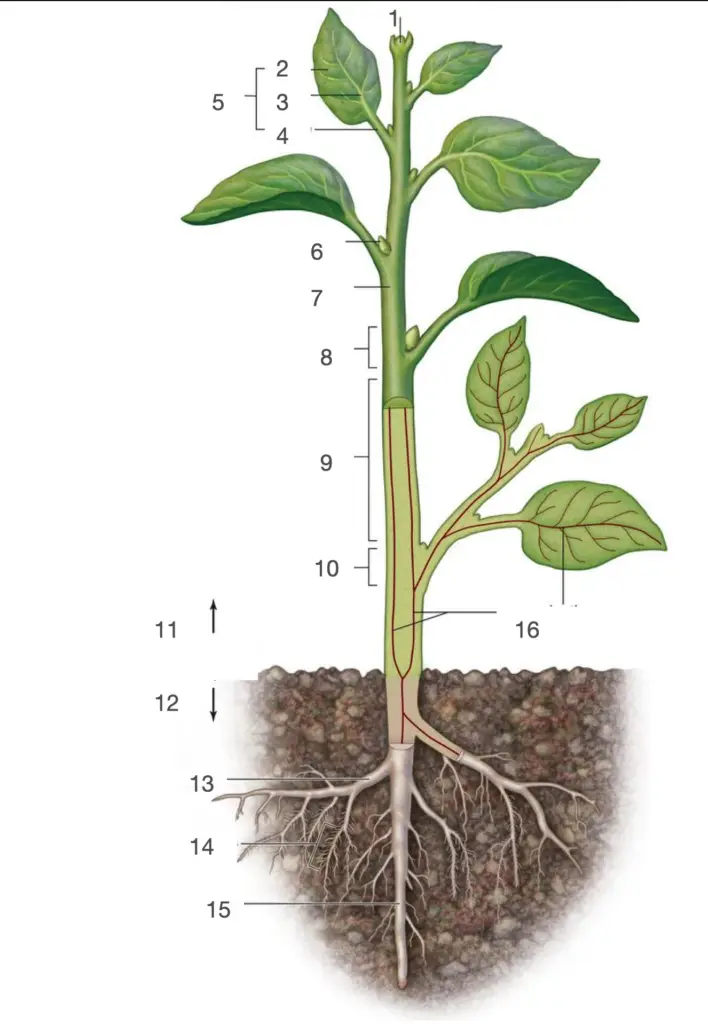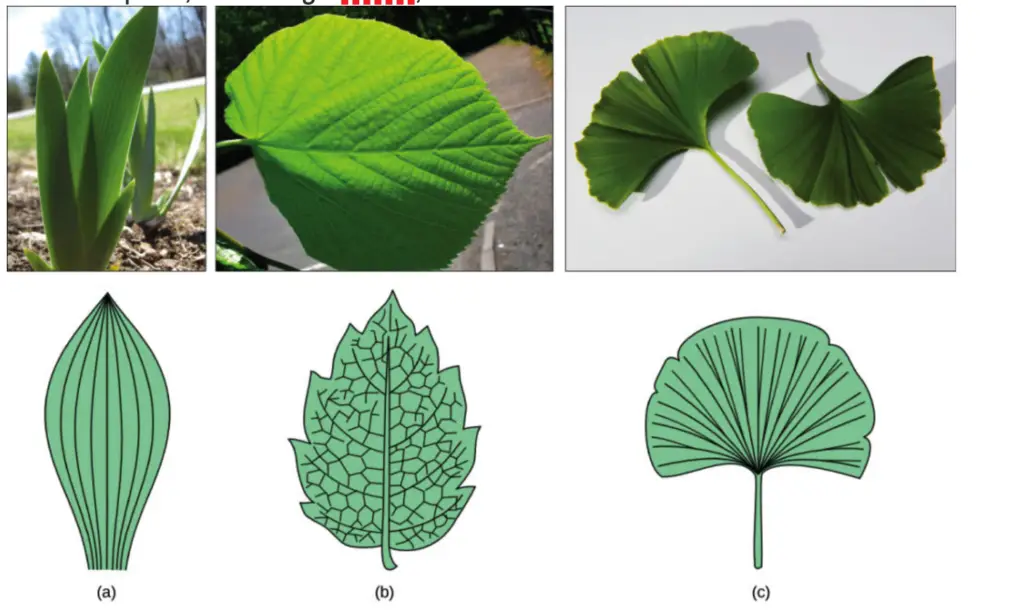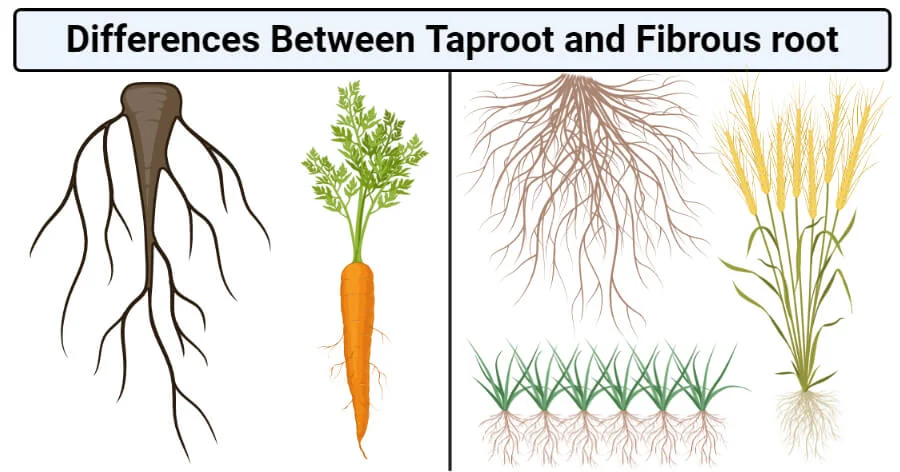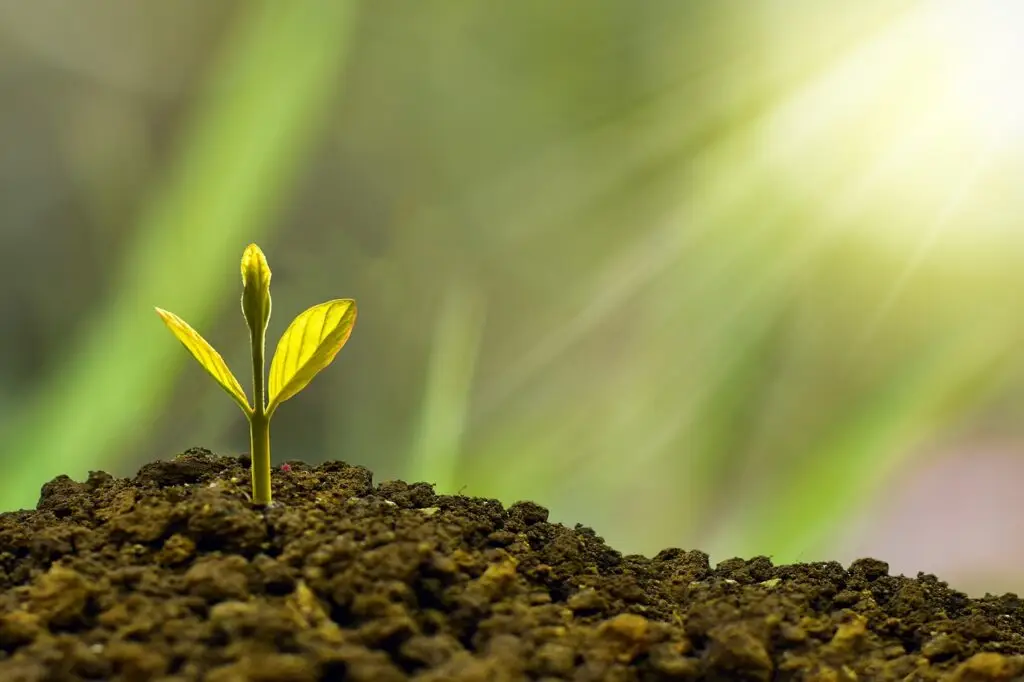Introduction to plant physiology
Flowering plants are those that have adapted best to all the physico-chemical conditions on Earth. They have colonized all environments, including extreme ones. And yet their basic organization is relatively simple. So let’s take a look at the typical structure of a flowering plant or Angiosperm…
I- Plant structure
Can you caption the diagram (numbers) of the plant structure with the text below

In plants, just as in animals, similar cells working together form a tissue. When different types of tissues work together to perform a unique function, they form an organ; organs working together form organ systems. Vascular plants have two distinct organ systems: a shoot system, and a root system. The shoot system consists of two portions: the vegetative (non-reproductive) parts of the plant, such as the leaves and the stems, and the reproductive parts of the plant, which include flowers and fruits. The shoot system generally grows above ground, where it absorbs the light needed for photosynthesis. The root system, which supports the plants and absorbs water and minerals, is usually underground. The shoot system of a plant consists of leaves, stems, flowers, and fruits. The root system anchors the plant while absorbing water and minerals from the soil.
The shoot system :
Stems are usually above ground, although the stems of some plants, such as the potato, also grow underground. Stems may be herbaceous (soft) or woody in nature. Their main function is to provide support to the plant, holding leaves, flowers and buds; in some cases, stems also store food for the plant. A stem may be unbranched, like that of a palm tree, or it may be highly branched, like that of a magnolia tree. Plant stems, whether above or below ground, are characterized by the presence of nodes and internodes. Nodes are points of attachment for leaves, aerial roots, and flowers. The stem region between two nodes is called an internode. The stalk that extends from the stem to the base of the leaf is the petiole. An axillary bud is usually found in the axil—the area between the base of a leaf and the stem—where it can give rise to a branch or a flower. The apex (tip) of the shoot contains the apical meristem within the apical bud.
The leaves :
Each leaf typically has a leaf blade called the lamina, which is also the widest part of the leaf. Some leaves are attached to the plant stem by a petiole. Leaves that do not have a petiole and are directly attached to the plant stem are called sessile leaves. Small green appendages usually found at the base of the petiole are known as stipules. Most leaves have a midrib, which travels the length of the leaf and branches to each side to produce veins of vascular tissue. The edge of the leaf is called the margin.
Within each leaf, the vascular tissue forms veins. The arrangement of veins in a leaf is called the venation pattern. Monocots and dicots differ in their patterns of venation. Monocots have parallel venation; the veins run in straight lines across the length of the leaf without converging at a point. In dicots, however, the veins of the leaf have a net-like appearance, forming a pattern known as reticulate venation. One extant plant, the Ginkgo biloba, has dichotomous venation where the veins fork.

(a) Tulip (Tulipa), a monocot, has leaves with parallel venation. The netlike venation in this (b) linden (Tilia cordata) leaf distinguishes it as a dicot. The (c) Ginkgo biloba tree has dichotomous venation.
credit a photo: modification of work by « Drewboy64″/Wikimedia Commons; credit b photo: modification of work by Roger Griffith; credit c photo: modification of work by « geishaboy500″/Flickr; credit abc illustrations: modification of work by Agnieszka Kwiecień
The Root system :
Root systems are mainly of two types. Dicots have a tap root system, while monocots have a fibrous root system. A tap root system has a main root that grows down vertically, and from which many smaller lateral roots arise. Dandelions are a good example; their tap roots usually break off when trying to pull these weeds, and they can regrow another shoot from the remaining root). A tap root system penetrates deep into the soil. In contrast, a fibrous root system is located closer to the soil surface, and forms a dense network of roots that also helps prevent soil erosion (lawn grasses are a good example, as are wheat, rice, and corn). Some plants have a combination of tap roots and fibrous roots. Plants that grow in dry areas often have deep root systems, whereas plants growing in areas with abundant water are likely to have shallower root systems.
Root growth begins with seed germination. When the plant embryo emerges from the seed, the radicle of the embryo forms the root system. The tip of the root is protected by the root cap, a structure exclusive to roots and unlike any other plant structure. The root cap is continuously replaced because it gets damaged easily as the root pushes through soil. The epidermis provides protection and helps in absorption. Root hairs, which are extensions of root epidermal cells, increase the surface area of the root, greatly contributing to the absorption of water and minerals.

II- The leaf structure
With the model of the leaf structure cube, build your own leaf.
Then adjust your cube as you want to explain to your neighbour how a leaf is organized.

d’après https://www.nursinghero.com/study-guides/wmopen-biology2/plant-structures
Help yourself with the next diagram and the text below.
Explanations: the central mesophyll is sandwiched between an upper and lower epidermis. The mesophyll has two layers: an upper palisade layer comprised of tightly packed, columnar cells, and a lower spongy layer, comprised of loosely packed, irregularly shaped cells. Stomata on the leaf underside allow gas exchange. A waxy cuticle covers all aerial surfaces of land plants to minimize water loss. These leaf layers are clearly visible in the scanning electron microscope (SEM) picture (b). The numerous small bumps in the palisade parenchyma cells are chloroplasts. Chloroplasts are also present in the spongy parenchyma, but are not as obvious. The bumps protruding from the lower surface of the leave are glandular trichomes, which differ in structure from the stalked trichome.
Functions of leaves explained to a child
- Photosynthesis: The making of food in a plant. Through this process they obtain the food they need to live.
- Gas exchange: they take in carbon dioxide and release oxygen.
- Transpiration: They lose water through their leaves. As a result, fresh water enters the leaves through the midrib and veins.
- Food storage.
Vocabulary:

ANki Flahcards:

